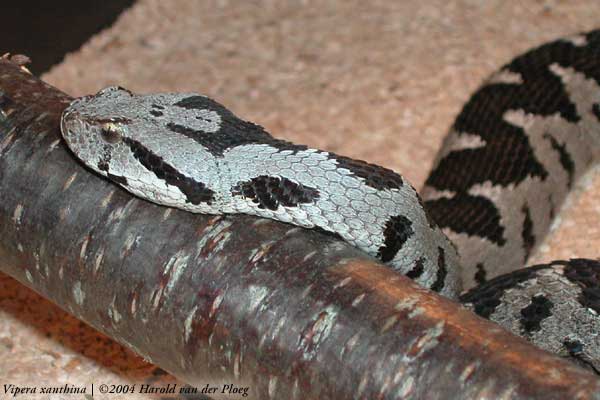
Montivipera xanthina (*)
Superregnum: Eukaryota
Regnum: Animalia
Subregnum: Eumetazoa
Cladus: Bilateria
Cladus: Nephrozoa
Superphylum: Deuterostomia
Phylum: Chordata
Cladus: Craniata
Subphylum: Vertebrata
Infraphylum: Gnathostomata
Superclassis: Tetrapoda
Cladus: Reptiliomorpha
Cladus: Amniota
Classis: Reptilia
Cladus: Eureptilia
Cladus: Romeriida
Subclassis: Diapsida
Cladus: Sauria
Infraclassis: Lepidosauromorpha
Superordo: Lepidosauria
Ordo: Squamata
Subordo: Serpentes
Infraordo: Caenophidia
Superfamilia: Viperoidea
Familia: Viperidae
Subfamilia: Viperinae
Genus: Montivipera
Species: Montivipera xanthina
Name
Montivipera xanthina (Gray, 1849)
Vernacular names
Deutsch: Kleinasiatische Bergotter
English: Rock viper, Coastal viper, Ottoman viper
Türkçe: Şeritli engerek
Montivipera xanthina is a venomous viper species found in northeastern Greece and Turkey, as well as certain islands in the Aegean Sea. No subspecies are currently recognized.[5]
Description
Dorsally, it is grey or white with a black zig-zag stripe. Melanistic individuals exist. It has keeled dorsal scales.[6]
It usually grows to a total length (body + tail) of 70–95 cm (27.6-37.4 in), but reaches a maximum total length of 130 cm (51.2 in) on certain Greek islands in the Aegean Sea.[4]
Behavior
Very aggressive, this snake will strike without provoking, and most bites inject venom.[citation needed]
Habitat
Montivipera xanthina can be found living in humid areas.[7] It favors rocky and "well-vegetated" areas for its habitat.[7]
Prey
The diet of M. xanthina is thought to consist of rodents and other small mammals and native birds.[7] It may prey on lizards, as well.[7]
Common names
Rock viper, coastal viper, Ottoman viper, Turkish viper, Near East viper,[4] mountain viper.[8]
Geographic range
Extreme northeastern Greece, the Greek islands of Simi, Skiathos, Kos, Kalimnos, Samothraki, Leros, Lipsos, Patmos, Samos, Chios and Lesbos, European Turkey, the western half of Anatolia (inland eastward to Kayseri), and islands (e.g. Chalki) of the Turkish mainland shelf.
The type locality given is "Xanthus" [southwestern Turkey (Kınık)], and "Asia Minor." Listed as "Xanthos" by Schwarz (1936). Nilson and Andrén (1986) restricted the species to "Xanthos" [= Xanthus] (Kınık) province Mugla, S. W. Turkish Anatolia" through lectotype designation.[2]
Conservation status
This species is classified as least concern according to the IUCN Red List of Threatened Species.[1] It is listed as such due to its wide distribution, presumed large population, and because it is unlikely to be declining fast enough to qualify for listing in a more threatened category. It is, however, listed as strictly protected (Appendix II) under the Berne Convention.[9]
Taxonomy
According to Nilson, Andrén and Flärdh (1990), M. bornmuelleri, M. bulgardaghica, M. wagneri and M. xanthina are all closely related and together form the Montivipera xanthina group or complex.[2]
References
Wolfgang Böhme; Petros Lymberakis; Varol Tok; Ismail H. Ugurtas; Murat Sevinç; Pierre-André Crochet; Yakup Kaska; Yusuf Kumlutaş; Aziz Avci; Nazan Üzüm; et al. (2009). "Montivipera xanthina". The IUCN Red List of Threatened Species. IUCN. 2009: e.T61537A86548598. doi:10.2305/IUCN.UK.2009.RLTS.T61537A12509884.en. Retrieved 9 January 2018.
McDiarmid RW, Campbell JA, Touré T. 1999. Snake Species of the World: A Taxonomic and Geographic Reference, Volume 1. Herpetologists' League. 511 pp. ISBN 1-893777-00-6 (series). ISBN 1-893777-01-4 (volume).
The Reptile Database. www.reptile-database.org
Mallow D, Ludwig D, Nilson G. 2003. True Vipers: Natural History and Toxinology of Old World Vipers. Malabar, Florida: Krieger Publishing Company. 359 pp. ISBN 0-89464-877-2.
"Vipera xanthina". Integrated Taxonomic Information System. Retrieved 19 August 2006.
"1000 Pictures - Free Desktop Wallpaper".
O'Shea, M. 2008. Venomous Snakes of the World. London: New Holland Publishers Ltd. 160 pp. ISBN 1-84773-086-8. (Vipera xanthina, p. 58.)
Gotch AF. 1986. Reptiles -- Their Latin Names Explained. Poole, UK: Blandford Press. 176 pp. ISBN 0-7137-1704-1.
Convention on the Conservation of European Wildlife and Natural Habitats, Appendix II at Council of Europe. Accessed 9 October 2006.
Further reading
Arnold, EN, Burton JA. 1978. A Field Guide to the Reptiles and Amphibians of Britain and Europe. London: Collins. 272 pp. ISBN 0-00-219318-3. (Vipera xanthina, p. 223 + Plate 40 + Map 126.)
Gray JE. 1849. Catalogue of the Specimens of Snakes in the Collection of the British Museum. London: Trustees of the British Museum. (Edward Newman, printer.) xv + 125 pp. (Daboia Xanthina, p. 24.)
Nilson G, Andrén C. 1986. The mountain vipers of the Middle East: The Vipera xanthina complex. Bonner Zoologische Monographien 20: 1-90.
Nilson G, Andrén C, and Flärdh B. 1990. Vipera albizona a new mountain viper from central Turkey, with comments on the isolating effects of the Anatolian "diagonal." Amphibia-Reptilia 11: 285-294.
Schwarz E. 1936. Untersuchungen über Systematik und Verbreitung der europäischen und mediterranen Ottern. Behringwerke-Mitteilungen 7: 159-262.
Retrieved from "http://en.wikipedia.org/"
All text is available under the terms of the GNU Free Documentation License

